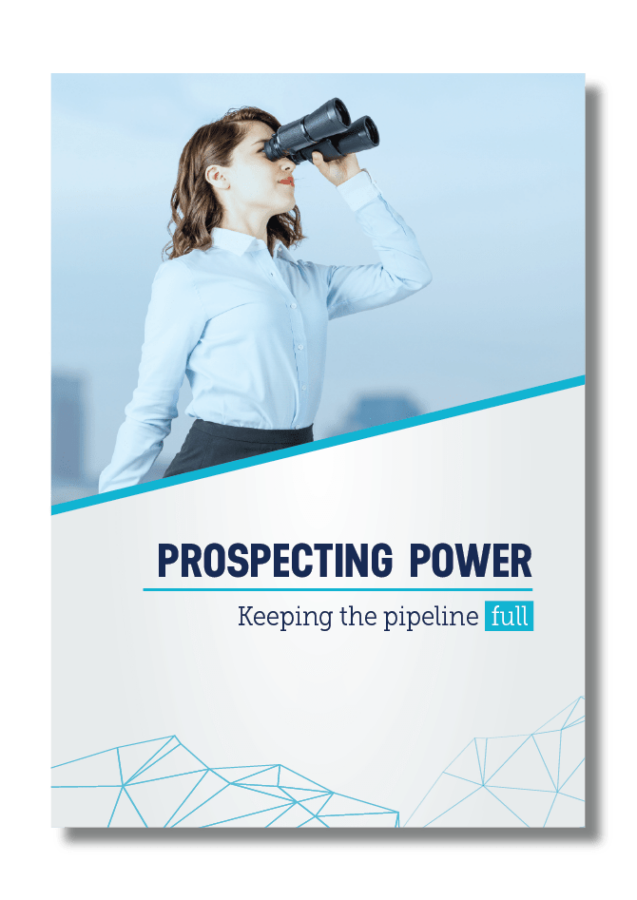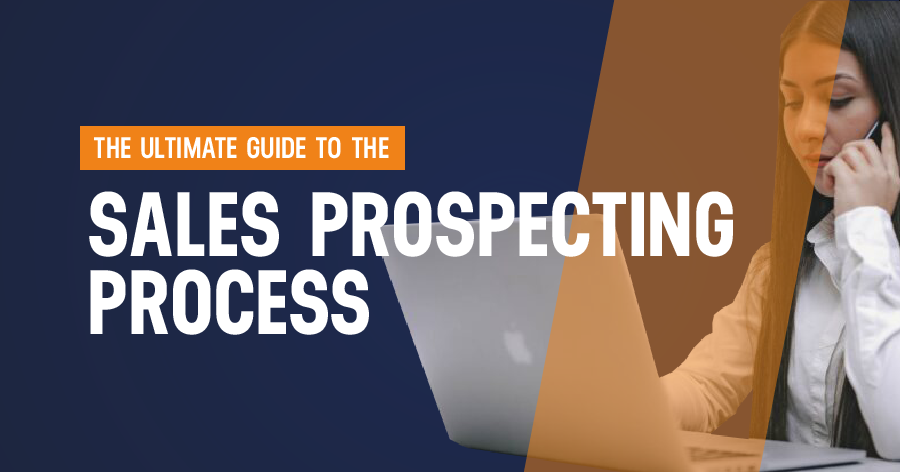
You’re far from alone if you internally groan when anyone mentions prospecting. An unsurprising 40% of salespeople say prospecting is the most challenging part of their sales process*. While there are many reasons for this, the most obvious is that prospecting is hard work – and frankly, it just isn’t as exciting as closing a deal. This is why we’re here to change this mindset: without a pipeline of leads, how will you ever close a deal? Read on below to discover our ultimate guide to the sales prospecting process, including tips, tools and templates to help you connect with buyers you can help.
- What is Prospecting in Sales? | Sales Prospecting Process Definition
- 9 Different Types of Prospects
- What are the stages in a sales pipeline?
- Why is the sales prospecting process important?
- How to prospect for sales
- Tips to improve your sales prospecting process
- Sales Prospecting Email Templates
- Sales prospecting tools every rep must have
- Best sales prospecting books
- Best Sales Prospecting Podcasts
- Discover a New Way to Generate Leads
What is Prospecting in Sales? | Sales Prospecting Process Definition
By definition, sales prospecting is finding potential buyers (also known as prospects) and reaching out to them to persuade them to enter your sales funnel – hoping they ultimately buy from you. That’s why, logically, if you can find prospective buyers who are adequately qualified and have pain points and needs that your offering solves – you’ll be far more likely to convert them at the end of your funnel. Overall, prospecting aims to build a prospect base, a list of current and potential customers.

Also read:
- Keep Your Pipeline Moving With THIS 5-Step Prospecting Plan
- Highly Effective 6-Part Phone Sales Scripts
- How to Master the Art of Cold Calling
What is the difference between lead generation and prospecting?
Sales professionals often use Sales prospecting and lead generation interchangeably; however, they are different. Lead generation refers to a long-term data-driven marketing activity, which is more of a one-to-many approach and is characterized by its purpose of building awareness and engagement of your broader market. In comparison, sales prospecting is a short-term activity for which sales representatives are responsible, and therefore, it is a one-on-one approach.
What’s the difference between a suspect vs a prospect?
Overall, the difference between the two is their level of qualification.

A sales suspect lingers in the awareness and interest sales process and funnels without any actual means or intention of buying your products or services. You suspect they fit your ideal customer persona, but you don’t have any other information about them, and they’re unwilling to engage consistently.
Comparatively, a sales prospect is a potential buyer of your product or service. Although they haven’t engaged with you yet or entered your sales process, they are someone who fits your ideal customer persona. Ideally, this means someone with the authority and readiness to purchase; they just haven’t been engaged by your offering yet.
Want to learn more? Read: Separating Suspects And Prospects: Improve The Leads In Your Funnel
9 Different Types of Prospects
You want to ensure you’re talking to a qualified prospect and know there’s a good chance of making the sale. To do so, discover 9 types of prospects to maximize your sales results and strengthen your prospecting process:
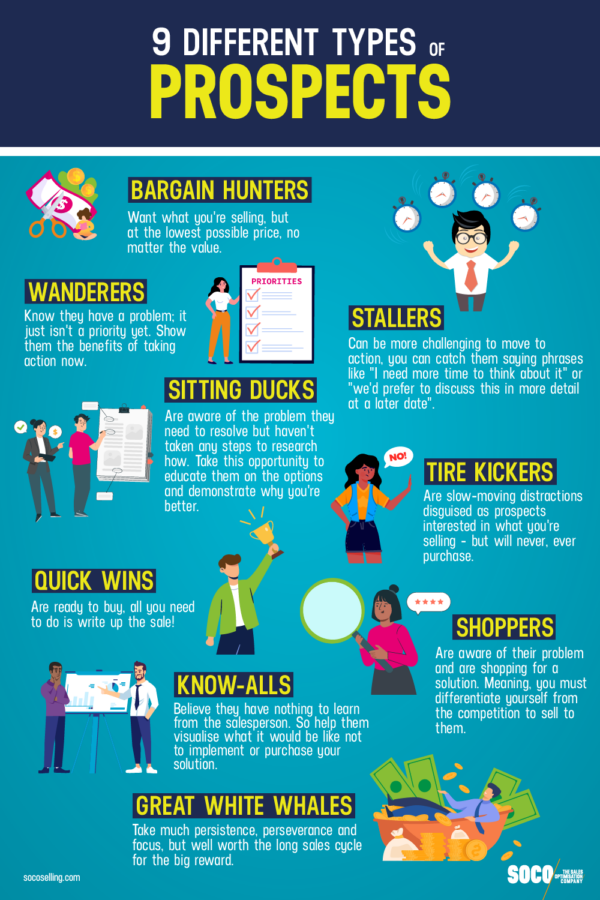
What are the stages in a sales pipeline?
The stages of a typical sales pipeline include all the major steps needed in a sales process to get prospects closer to a close. These include:
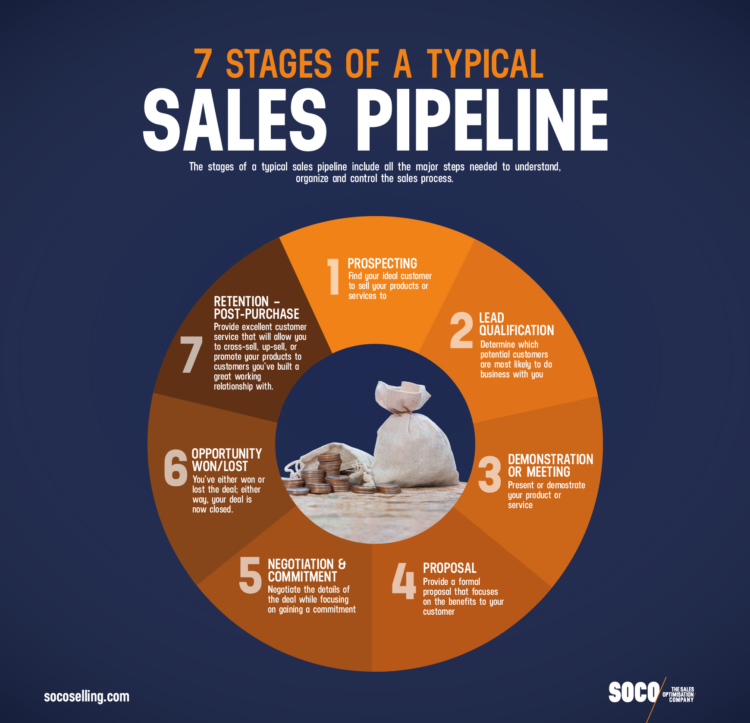
Learn more about managing your sales pipeline here: Sales Pipeline Management: How To Manage Your Pipeline And Shorten The Sales Process
Why is the sales prospecting process important?
All you want is leads, but you must first undertake a qualification process – prospecting. Too many sales reps jump directly from trying to generate leads straight into selling their sales pitch – but this approach is detrimental for several reasons, so what’s the importance of the sales prospecting process? Find out below!
1. Filling your pipeline
A full sales pipeline is the lifeblood of any organization – and when it works, you attract more prospective clients into becoming buyers – an increasingly important aspect of any sales rep’s job. Sales reps, in general, face a 15-20% loss of their prospective customer base every year due to gradual attrition – that’s why prospecting is essential in reducing the chances of your future customer base diminishing to nothing.
2. Data gathering
These days, data is everything because market research is at the heart of understanding our prospect’s greatest needs, challenges and pains. Ultimately, not every lead will become an instant sale – when this happens, sales reps can now find out why and how they entered the sales funnel, which can help you connect with similar prospects in the future. Not only does this data help you understand your prospective clients much better, which in turn helps them solve specific needs, but you can also use this information to develop future sales strategies and tactics.
3. Prospect feedback
Prospects are your audience, meaning they can provide valuable feedback to help streamline your overall sales strategy and pipeline. By asking for feedback, you can test whether your sales or marketing efforts are actually working – and if they’re not – why.
How to prospect for sales
Before we delve into the nitty-gritty of the sales prospecting process, it’s important to note that prospecting is successful when you use the channels you have available to you to their maximum ability. On that note, here are some traditional and modern prospecting channels you may opt to use in your sales prospecting strategy:
Traditional Prospecting VS Modern Prospecting Strategies
Prospecting has evolved, yet many people are still stuck in the past. It’s not to say that traditional prospecting strategies aren’t effective anymore, it’s that things have evolved and there are now more effective ways to prospect that either replace or complement old prospecting methods.
This infographic highlights traditional prospecting and the modern alternatives to consider. Here’s the difference between traditional and modern prospecting strategies.

Taking an Omnichannel approach to prospecting
An omnichannel prospecting approach is where you reach out to leads through multiple channels. An example of the different ways you can connect with prospects using an omnichannel approach includes using a combination of the following channels:
• Email
• Social (often LinkedIn)
• Phone
• WhatsApp/Messaging platforms
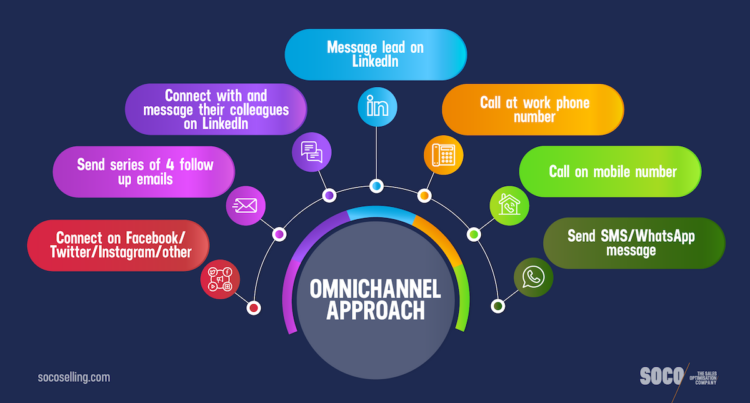
An omnichannel approach can’t easily be ignored. If a prospect receives an email, phone call, LinkedIn message and social media marketing all from the same company in the span of 2 weeks – they’ll be much more likely to respond to your marketing efforts and remember your brand.
How to prospect for sales in 6 steps
1. Create an ideal prospect profile
Too many sales professionals spend time on sales prospects who don’t need their offering, so the first step is to create an ideal customer persona. This method lets you quickly identify whether the prospect in front of you is a good fit – do they fall into your target market? Do they have the willingness and the means to buy it?
2. Research
Now that you have an ideal prospect profile, you can begin researching. At this stage, you should identify different sources where you’re sure you can find new leads to qualify as your prospect. When you do this, ensure you determine who the key decision-makers are.
3. Prioritise leads
Now you have your research and list of potential leads. You must prioritize your leads from strongest to weakest. By doing this, you’ll save precious time and effort while ensuring that you only go after the prospects most likely to become customers.
4. Send relevant content in the first touch
You have an organized list of leads, so it’s time to contact your prospects. You can use the above-mentioned methods (traditional vs modern) to make the first contact.
Usually, the best way to achieve this is to offer them something of value, like helpful content in the form of a webinar, blog post, case study or video. Try to use a resource that centers on their current challenges and pain points.
5. Build rapport
Your lead is finally interacting with you! But the job is not over yet. Prospecting is exploring a potential relationship for both the buyer and seller. That’s why at this stage, your focus should turn to building rapport and trust that convinces the prospect that they can benefit from this mutual relationship. Remember, people only buy from people they know, like and trust. If you’re struggling with this section, you should record your exchanges with prospects to determine where you went wrong later – and use this information to improve upon issues you may not have realized you had.
6. Follow up – follow up – follow up
Salespeople have to be persistent by nature; following up, checking in, and making constant contact with prospects is the name of the game. Unfortunately, you can’t just sit back and wait for a prospect to call you up and make an offer after an initial meeting. It’s not complicated, either. You can pick up the phone, send a quick email or touch base with a LinkedIn Voice Message to say, “Are you happy with the current proposal details?”, “Are there any additional amendments?” or “When can we start?”
Tips to improve your sales prospecting process
If you feel like you’ve got a decent understanding of your sales prospecting process but just need some tips to streamline it, check ours out below:
Identify your top 3 prospecting strategies
Identify only three top prospecting strategies to avoid putting all your eggs in one basket in just one way and to avoid spreading yourself too thin in time and money in more than three ways. Sticking to your top three forms of consistently reaching many of your ideal target customers is manageable and will keep you focused.
However, you must be focused because anything other than consistency doesn’t work. If you think you can hit the jackpot with a one-off advertisement in a newspaper or magazine, you need to think again. Spending thousands of dollars on that strategy will almost guarantee a negative return on your investment. And nothing is less effective than attending a networking event, making some good contacts, and not returning the following month and the month after. Your audience must see you as consistent and credible before it can trust your message.
Lastly, you must reach many prospects to achieve your income goals. Consider using Facebook and publishing a blog or an online newsletter to reach many customers.
Measure your results every step of the way
Once you have identified your top three prospecting strategies and started implementing them to reach your ideal target customers, be sure to measure the results.
For instance, you should track how many e-mail messages you sent last week or how many appointments you scheduled compared with how many prospecting e-mail messages you sent. Look at the number of appointments divided by the number of sales made. Look at the number of e-mail messages sent and how long it took you to send them. Look at the dollar amount in sales divided by the number of hours it took to send those e-mail messages.
By making these comparisons, you can see which are the most effective ways of getting customers. Ask yourself:
- What should you be doing more of?
- What should you be doing less of?
- How many times did you gain exposure to your ideal audience?
- How much did each form of exposure cost you in terms of money and time?
- How many inquiries did you get as a result?
- How many presentations came out of those inquiries?
- How many sales came from those presentations?
Sales Prospecting Email Templates
If you’re looking for a helpful sales prospecting email template, you’re in the right place! Copy and paste one of our best templates below, and start connecting with prospects today. First, though, ensure you understand the three elements that make up these great sales prospecting emails:
3 elements of a great sales prospecting email
Before we delve into our best sales prospecting email templates that you can use to engage cold prospects, it’s best first to understand the makeup of an excellent sales prospecting email. Check out the three essential elements that need to be in yours:
1. A reason
Yes, you know what your company offers – but what is the value to your prospect? Simply having the lure of a new product release or special promotion isn’t enough – prospects want to know what’s in it for them.
2. A pressing reason
Simply stating your offering isn’t enough. What’s the actual reason your prospects should move to action? For instance, if there’s no relevant pain point, fear of missing out, trigger event, or promotion, there’s no real reason to buy. Tell your prospect why you’re reaching out – and what’s in it for them.
3. A CTA
Every stage of your interactions with prospective clients should have a step that drives the sale forward; prospective sales emails are no different. Tell your prospect explicitly what you want them to do next, whether meeting with you for a 15-minute phone call or simply asking them to sign up for your newsletter for more actionable, helpful tips.
Cold email templates
Also read: 51 Sales Email Subject Lines That Will Increase Your Open Rate
1. [Prospect name], need help with [specific challenge]?
Hi (Prospect name),
Are you struggling with (specific issue) at (company name)?
I know from working with companies like yours, such as (name drop competitors) that the struggle is real.
I have a couple of ideas that might help – can we schedule a time to discuss this?
(Your signature)
P.S. In the meantime, check out these resources I’ve put together that address (specific issue).
2. [Pain-point] making you [emotion]? I can help.
Hi (Prospect name),
From your website and socials, I can tell that you’re trying to (accomplish/solve a specific goal or challenge your solution addresses).
Without making too many assumptions about your goals, I’m optimistic (your solution) can play a pivotal role in your success.
While I’m familiar with your company, you might not be familiar with (your company name). We help businesses in (prospect industry) with three main goals:
- (Your benefit #1)
- (Your benefit #2)
- (Your benefit #3)
Are you free on [day] at [time] for a short call to discuss how I can help?
[Your email signature]
3. A better way to solve [challenge]
Hi (Prospect name),
I’ll keep this short; I know you’re busy.
As a (your title) at (your company name), I speak with people like you about (solving a challenge). (Prospect company name) is on my radar because we’ve helped many similar companies in (prospect industry) with (specific issue).
Can I schedule a 10-minute call with you to discuss your strategy for overcoming (prospect challenge)? Hopefully, I can provide some insight into how best to achieve this – alongside some actionable tips for the meantime.
Best,
(Your signature)
4. Can you help me?
Hi (Prospect name)!
I’m trying to figure out who is in charge of (the situation you solve) at (prospect company name).
Would you mind pointing me in the right direction – or directly connecting me with the person in question?
Best,
(Your signature)
Sales prospecting tools every rep must have

You’re a hunter bringing in new leads, so you need the tools to match. That’s why we’ve compiled a list of the best sales prospecting tools so that you can gain leads quicker, easier and more intelligently than ever before. Check them out below:
LinkedIn Sales Navigator
You know LinkedIn, the world’s largest professional social network, recently launched LinkedIn Sales Navigator – a prospecting tool engineered explicitly for sales reps. It has powerful advanced search filters, displays and detailed information on prospects – allowing you to save and recommend leads at the click of a button.
Growbots – Prospecting with AI
Growbots ends your manual customer search and replaces it with automated customer prospecting, which really works. You can create custom criteria to locate the perfect prospect for your company. Growbots constantly updates its database of over 200 million decision-makers and has a less than 10% bounce rate. You can build relationships with prospects effortlessly through automated follow-ups and email marketing campaigns.
Hunter
Hunter is a tool for finding professional prospects’ email addresses and phone numbers with just a button click. All you have to do is enter a domain name to launch your search. For example, socoselling.com
Leadfeeder
Leadfeeder is a buyer intent data tool that turns anonymous web traffic into actionable data. Leadfeeder identifies the companies visiting your site, how they got there, their behavior, and their intent to purchase.
Catch our interview with Chief Marketing Officer Andy Culligan, who discusses How Sales And Marketing Increase Revenue Together.
Woodpecker
Woodpecker.co is an email marketing automation tool that lets you send emails and follow-ups from Gmail and Outlook. It’s mostly used by B2B companies looking to personalize, track and automate their outbound sales campaigns.
Lusha
Lusha is a B2B prospecting platform that offers salespeople from all company sizes accessible data through self-service products.
Expandi.io
Touted as the world’s safest software for growth hacking on LinkedIn, Expandi.io is an alternative LinkedIn Automation Software that helps you gather more business by growing an expanded network of prospects.
Catch our interview with CEO and founder Stefan Smulders, and gain 5 LinkedIn Outreach Tricks To Generate High-Quality B2B Leads.
Best sales prospecting books
Stay on top of the latest trends, strategies, tips and tricks regarding the sales prospecting process by checking out these recommended resources below:
Social Selling: 10 Essential Strategies to Prospect, Position and Present Using Social Media – Tom Abbott
Reason To Read
SOCO Sales Training founder and CEO Tom Abbott wrote Social Selling: 10 Essential Strategies to Prospect, Position and Present Using Social Media because, as a fellow sales professional and business owner, it’s exactly the book he needed when starting to prospect with social media about ten years ago. Grab yourself a copy if you want to use social media to find your audience, have conversations with prospects, generate sales leads and get past gatekeepers to fill your sales pipeline.
The first step is to join discussions in which prospects are sharing their challenges and goals. Let’s focus on having online conversations with prospects and allowing them to clarify their needs. It’s time to embark on a fact-finding mission.
Excerpt: Chapter 2 | Have Conversations with Prospects
Published May 11th 2015
Pages 94
Fanatical Prospecting — Jeb Blount
Reason To Read
Fanatical Prospecting is a detailed resource that explores contemporary sales prospecting process strategies and primarily centers around effectively beginning a conversation with a prospect regardless of the channel: social, telephone or email.
Published September 20, 2016
High-Profit Prospecting — Mark Hunter, CSP and Mike Weinberg
Reason To Read
High-Profit Prospecting focuses on identifying the challenges of traditional sales prospecting process techniques like cold calling. It then offers advice, tips and tricks on how to maximize the value produced by using traditional channels – alongside a discussion on how best to contact and engage c-suite level prospects.
Published September 20, 2016
Pages 224
Predictable Prospecting — Marylou Tyler and Jeremy Donovan
Reason to read
Predictable Prospecting is a must-have resource for B2B businesses, full of helpful and actionable strategies you can apply to your sales prospecting process immediately. Follow the step-by-step framework and turn your organization into a high-performance business development powerhouse with diversified lead generation channels.
Published August 15, 2016
Pages 256
Best Sales Prospecting Podcasts
To help you navigate the prospecting sales podcast landscape, we’ve highlighted below some of the sales podcasts that we think are the best. Whether you’re a young sales rep looking to make your first mark or a sales veteran looking to brush up on new techniques, we have a vast selection to suit all needs.
1. Blissful Prospecting
Hosted by Jason Bay, Chief Prospecting Officer and sales trainer at Blissful Prospecting, his unique prospecting podcasts cover everything from cold calling, outreach sequencing, discovery calls and cold emailing. Check it out if you’re ready to get the best sales prospecting secrets from a featured expert each episode, and walk away with actionable tips to put your prospecting plan into motion.
Notable Episodes: We’ve had the pleasure of talking to good friend Jason Bay on our own podcast, “Selling in Asia.”, check out the episode here: 3 Steps to Blissful Prospecting With Jason Bay
2. Predictable Revenue
Hosted by Predictable Revenue’s CEO, Colin Stewart and co-hosted by the best-selling author of Predictable Revenue and early Salesforce employee, Aaron Ross, this podcast interviews outbound sales leaders so that you can learn directly from the people on the front lines.
Notable Episodes: Check out Tom’s episode with Colin, “How to turn 100 LinkedIn profiles into 10 meetings”, where they discuss how there’s a time in a company’s growth when inbound leads – robust as they can be just don’t cut it anymore.
- Host: Collin Stewart & Aaron Ross
- Episode Length: 30 -45 minutes
- Where to listen: iTunes | YouTube | Spotify
Discover a New Way to Generate Leads
Like blood to a body, a full sales pipeline is necessary for your business to survive. The thing is, prospecting has evolved, and old methods just aren’t effective anymore.
Our Prospecting Power Training teaches participants how to ensure your customer acquisition strategy is creative, persistent, and, most importantly, generates real results.
